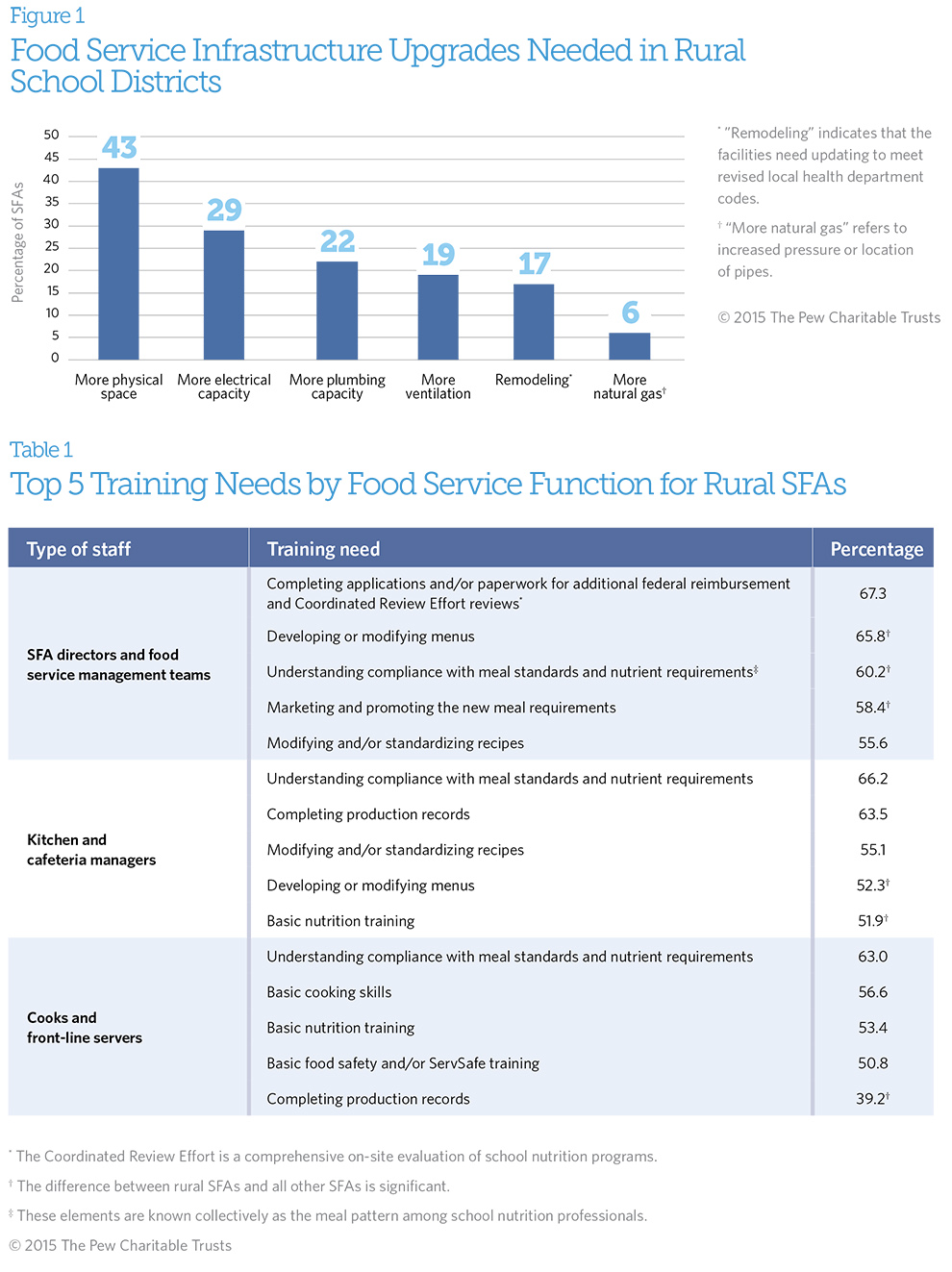Rural School Districts Need Kitchen Upgrades
Overview
Across the country, school food is becoming healthier. The U.S. Department of Agriculture has issued updated nutrition standards that have led to meals with more fruit, vegetables, low-fat dairy products, and whole grains; with less fat, sugar, and salt; and without excessive calories. The vast majority of schools are meeting these standards. Unfortunately, many lack the right tools and must rely on expensive, inefficient, and unsustainable workarounds to prepare healthy and appealing meals.
To assess the needs of districts for kitchen equipment, infrastructure, and food service training, the Kids’ Safe and Healthful Foods Project—a collaboration of The Pew Charitable Trusts and the Robert Wood Johnson Foundation—commissioned a survey of the school food authorities* (SFAs) that administer the National School Lunch Program and the School Breakfast Program.† This brief describes the facility and staffing challenges and opportunities faced by SFAs in rural‡ areas as they strive to serve delicious meals that meet the USDA’s nutrition standards.
Based on survey responses, approximately 8,500, or 62 percent, of all SFAs serve rural communities.
Expected cooking changes in rural schools
To meet updated nutrition standards, rural SFAs made or expected to make changes that could affect their equipment, infrastructure, and training needs. For example, schools may need to increase refrigerated storage space to accommodate larger quantities of fresh foods. Among respondents serving rural communities:
- 83 percent implemented or plan to implement standard recipes and/or work methods.
- 58 percent moved or expected to move to more scratch cooking.
* A school food authority is the local administrative unit that operates the national school breakfast and lunch programs for one or more school districts.
† This issue brief is part of the Serving Healthy School Meals series of reports that addressed the topics of districts’ readiness to meet updated nutrition standards, school food service equipment and infrastructure needs, and districts’ staff development and training needs related to implementation of the updated nutrition standards. For more detailed findings and to read earlier reports, visit healthyschoolfoodsnow.org.
‡ The term “rural” was not defined in the survey and was self-reported by respondents.
Kitchen equipment needs and costs
On average, rural SFAs need $65,470 in kitchen equipment per school, compared with $68,682 per school for all other SFAs. Districts often do not have the financial resources to make these improvements, which is particularly true in rural communities. Rural SFAs were significantly less likely than all other SFAs to report having a plan for equipment replacement and upgrades (21 percent versus 26 percent) and a line item for capital equipment purchases in their annual budget (37 percent versus 42 percent).
Top equipment needs
When asked about their needs in relation to meeting nutrition standards, the majority of respondents said that serving a greater variety of fruits and vegetables presented their greatest equipment challenges.
When asked what specific equipment they need to meet all of the nutrition standards, rural districts responded:
- 43 percent: Sets of knives with cutting boards. Without the right knives, preparation takes more time and poses safety risks for food service staff.
- 43 percent: Utility carts. This equipment is used to transport items within a kitchen or cafeteria. Without enough carts, food service personnel must carry items and make multiple trips that waste valuable time.
- 43 percent: Serving-portion utensils. Serving utensils determine appropriate portion sizes. Without them, servings could be measured inaccurately.
- 42 percent: Food processors. Without bulk processors, school cooks must cut and mix foods by hand or prepare recipes in smaller, less-efficient batches.
- 39 percent: Scales. Industrial scales weigh bulk ingredients. Without them, ingredients must be weighed in smaller batches—a process that is time-consuming, inefficient, and potentially fraught with error.
Kitchen infrastructure upgrades
Food service infrastructure capacity is a crucial component of the efforts to serve heathy school meals that meet the USDA’s nutrition standards. For example, new equipment such as walk-in refrigerators and freezers may require upgrades to electrical systems.
The top infrastructure need for rural SFAs was additional physical space in their school kitchens. (See Figure 1.)
Food service training needs
To meet the new meal requirements, the majority of SFAs expected to make at least one change in their production approach. Such changes may require additional training in cooking skills, food safety, and the use of new ingredients and kitchen equipment. (See Table 1 for the top training needs for school food service professionals in rural SFAs.)
Conclusion
Schools are doing their best to provide students with meals that meet national nutrition standards, but most need some help to supply their kitchens and staff with the right tools for this important work. Addressing the equipment, infrastructure, and personnel training needs would help schools efficiently store, prepare, and serve healthy and appealing foods.







